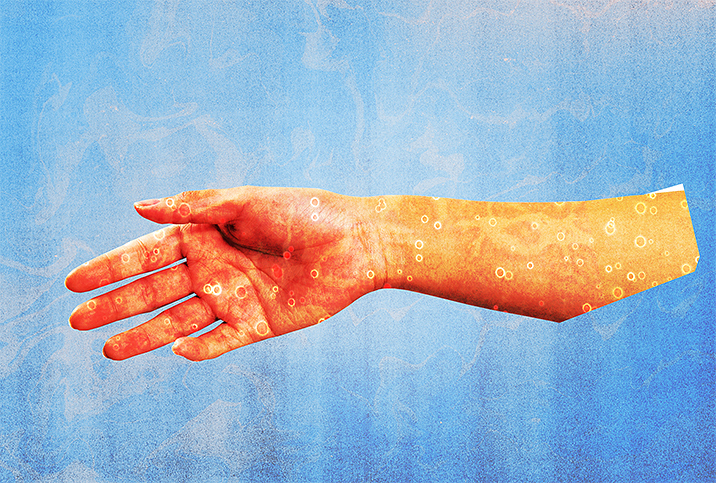The Wildest $#*t Syphilis Can Do to You

On the long list of sexually transmitted diseases (STDs), syphilis has long been relegated to the "Oh, yeah, and this too..." section. It feels like there are more urgent STDs to talk about: HIV, gonorrhea and chlamydia, as well as the sexually transmitted infection (STI) HPV, which bears a cervical cancer threat. It's little wonder syphilis gets pushed into the background.
However, despite its near-eradication after World War II with the advent of penicillin, syphilis is getting the band back together for a reunion tour, and recent outbreaks in Australia, Oklahoma and Northern California have health officials sounding the alarm.
Stages and symptoms
Here's how syphilis progresses at each stage of the disease, according to the Centers for Disease Control and Prevention (CDC).
Primary syphilis
Syphilis starts with a single small sore, or chancre, at the point where the disease enters the body. It spreads by sexual contact, so the sore is usually on the genitals but may be hidden inside the mouth, vagina or rectum.
The canker sore is painless, so the infected person may not even notice it. It doesn't appear until about three weeks after contact and disappears after three to six weeks, regardless of whether it's treated or not. You may declare you're cured even if you do nothing.
Secondary syphilis
The second stage of the disease presents as a skin rash and/or lesions in the mouth, vagina or anus. It may appear as the initial chancre is healing, or the rash could appear some weeks after the chancre goes away.
Typically, this rash appears as red, rough or brownish-red spots on the palms of the hands and bottoms of the feet, and sometimes it covers the torso. It's generally not itchy and may be accompanied by gray or white raised lesions in the mouth, groin or underarms.
Fever, swollen lymph glands, sore throat, hair loss, headaches, weight loss and fatigue are other potential symptoms, but these also disappear eventually, with or without treatment.
Latent syphilis
Arguably the most dangerous symptom of syphilis is having no symptoms at all. In the latent phase, a person could walk around carrying the infection for years or even decades—with the ability to spread it to others—and never know it.
Tertiary syphilis
If and when this stage appears—and that could be 10 to 30 years after initial infection—it can affect the brain, nervous system, heart, blood vessels, eyes, bones, joints, liver and more. It can cause blindness, severe headaches, altered behavior, problems with coordination, paralysis, dementia and nervous system symptoms.
Untreated, the damage done to your internal organs by syphilis can result in death.
Let's get historical
Believe it or not, these symptoms are pretty tame compared to what syphilis used to do to people in the days when legitimate medication of any kind was unavailable to treat the disease.
Syphilis was first well-documented in 1495, when French troops attacked Naples and became infected by the thousands, and then went on to spread it across Europe. Soldiers were struck with genital sores that morphed into foul-smelling abscesses and pustules covering their entire bodies. It would eat into their skin and even burrow into their bones, and often result in death—but not before excruciating pain.
Syphilis in the good old days would famously eat your flesh, causing body parts to literally drop from your face, typically the nose to start with, followed by the lips. The eyes could be eaten away, too.
The disease is believed to have infected more than 1 million people across Europe at its height. One 2020 study published in the Economic History Review determined 20 percent of people between the ages of 15 and 34 in 1770s London were treated for syphilis.
In 2019 there were 129,813 new cases of syphilis, according to the CDC. Compare that, say, to the 37,968 new cases of HIV diagnosed in the same year.
Scholars disagree on where the disease originated, but there's no denying syphilis back then was a much more virulent and nasty strain than today's variant.
And if you thought the disease was terrible, let's talk about what passed for treatment.
The most widely administered treatments for four centuries involved mercury, in any form from pills to ointments to —prepare yourself—urethral syringes.
That's the kind of cure that likely led to many simply shrugging and saying, "Hey, do I really need my nose?" Seriously: Artificial noses were commonplace at the height of syphilis, as well as some grotesque attempts at early rhinoplasty.
In later years, specifically starting in 1917, some doctors fought fire with fire, following one Julius Wagner-Jauregg's treatment plan of inducing malaria in syphilis patients. Malaria would cause high fevers that would kill the infecting bacteria responsible for syphilis, and then quinine would eliminate the malaria. Perfect plan, right? Unfortunately, syphilis relapse rates were high at 60 percent, and up to a fifth of patients who received this treatment died from their fevers. But to many doctors hoping to save their patients, anything was worth a shot in the face of this dominant and deadly infection.
Back to the future
It's entertaining to reminisce about the golden days of syphilis, but cases in the here and now are not encouraging. In 2019 there were 129,813 new cases of syphilis, according to the CDC. Compare that, say, to the 37,968 new cases of HIV diagnosed in the same year.
Noses aren't dropping in the streets yet, but this disease isn't nearly as dead and gone as we like to think—not by a long shot. And with other STDs developing antibiotic resistance, it's hard to say what the trajectory of the disease really holds. It's unlikely we'll see a repeat of syphilis' heyday, but it's an issue worth addressing—or at least keeping in mind the next time you forgo a condom.


















